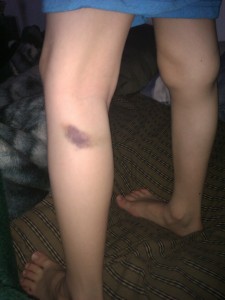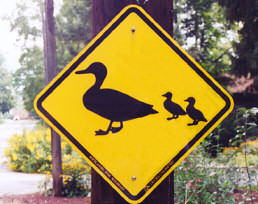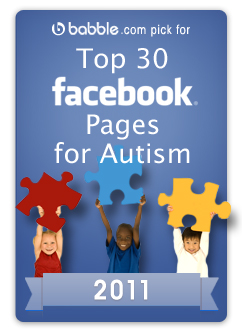One of the biggest problems with Autism, whether your child is verbal or non verbal, is the lack of information. Even if your child speaks quite well, there’s a good chance that you won’t get the information out of them that you’re looking for.
In my case, this is never more apparent than when my son has a random cut, scrape or bruise on his body. And I don’t intend to speak for everyone but I have spoken to more than enough other parents to realize that this isn’t isolated to just my experience.
Introducing the bruise
 This bruise, pictured right (click to see full size), appeared on my son’s leg this week-end. It’s in the back of his leg, under his knee… which leaves us wondering if it was there sooner and we just didn’t notice, if it appeared during the week-end at some random point or if it actually happened this week-end.
This bruise, pictured right (click to see full size), appeared on my son’s leg this week-end. It’s in the back of his leg, under his knee… which leaves us wondering if it was there sooner and we just didn’t notice, if it appeared during the week-end at some random point or if it actually happened this week-end.
The problem is this… my son doesn’t remember how he got it. This isn’t surprising because most people really don’t remember getting a bruise, since it tends to appear well after the impact that caused it.
But in my son’s case, and I assume many Autistic cases, this is bit more common.
Of all the things he remembers….
My son, like many (but not all) Autistics, has quite the amazing memory. He can hear a story book one time in September and remember it word for word in April. He remembers games I played with him when he was just 1. But ask him how he got a scratch on his face, or a scrape on his arm or, in this case, a bruise on his leg… and he simply will not have an answer.
I’m not sure if it’s selective memory blocking… you know, not wanting to be able to recall a painful event, or if that sort of event really just doesn’t get stored in there sometimes.
What I do know is that it’s not an ideal situation. I don’t mean that from just a convenience stand point but from a safety stand point.
As a parent, you see these injuries and wonder if there is a bully, an abuser, an unsafe environment… you want your child to be safe and not having the information sends your mind into overdrive. Chances are though, he just fell down, hit something too hard, tripped over another student or who knows what… but it’s probably just one of many sores that children are going to get. They play pretty hard.
The Mystery
Still, we’re left wondering. How did this bruise happen? It’s nearly black. It’s very big and not only that, what you don’t see in the picture is that it goes straight across the back of his leg and even appears much more lightly on the other leg.
To me, this means he got whacked with something (like a stick) or that he fell back against something like a hard chair or something.
I’m fairly certain that it’s an innocent bruise (no one intentionally hurt him) but again, I don’t know what did it because he doesn’t know.
As a parent, that’s scary. As a parent of a child with Autism, it’s one more issue to deal with on top of countless others.
If there are studies on this, I am unaware of them. I’m not even sure how they could study something like this. But I suspect that if it was possible, the results would show that I’m not the only parent that has to play detective to find the cause of random injuries. In fact, I would wager that it’s all too common.
Do this happen with you and your children? Please share your experiences.













